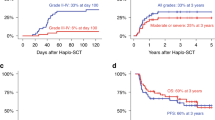Abstract
To improve the results of high-dose therapy with autologous stem cell transplantation, new conditioning regimens with acceptable toxicity must be developed. The aim of this study was to evaluate the feasibility and toxicity of two myeloablative regimens performed at a 2-month interval. After salvage chemotherapy and collection of peripheral stem cell progenitors (median CD34+ cells/kg: 11 × 106/kg), (n = 15) patients with aggressive non-Hodgkin’s lymphoma with poor prognostic factors or refractory Hodgkin’s disease (n= 9) received intensified regimens. The first conditioning regimen, consisting of BCNU–cyclophosphamide–VP16–mitoxantrone was followed by transplantation of a median number of 4 × 106 CD34+ cells/kg; then, after a median interval of 56 days, a second preparative regimen, combining busulfan–aracytine–melphalan or TBI + aracytine–melphalan, was followed by transplantation of a median of 4 × 106 CD34+ cells/kg. After regimens 1 and 2, respectively: median time to neutrophil recovery >500/μl was 11 days (both times); median time to platelet counts >50 000/μl was 14 and 36 days, but values >20 000/μl were reached by days 13 and 16 (P = 0.9); mucositis grade III–IV was observed in 11 and 15 cases. The median number of days with fever >38°C was significantly higher (7.8 days) after the second transplant (P <0.05). three cases of veno-occlusive disease (vod) were observed after the second transplant. at a median follow-up of 18 months, 14/24 (58%) patients remained in cr, seven patients had died (two of vod and five after relapse) and two were alive in relapse. these results indicate that tandem transplants performed at a 2-month interval in poor risk lymphoma can be used with acceptable hematotoxicity. vod remains the major drawback and hepatotoxic drugs, such as busulfan, should be used with caution. longer term follow-up of a larger cohort of patients is needed to ascertain the overall efficacy.
This is a preview of subscription content, access via your institution
Access options
Subscribe to this journal
Receive 12 print issues and online access
$259.00 per year
only $21.58 per issue
Buy this article
- Purchase on Springer Link
- Instant access to full article PDF
Prices may be subject to local taxes which are calculated during checkout
Similar content being viewed by others
Author information
Authors and Affiliations
Rights and permissions
About this article
Cite this article
Fitoussi, O., Simon, D., Brice, P. et al. Tandem transplant of peripheral blood stem cells for patients with poor-prognosis Hodgkins’s disease or non-Hodgkin’s lymphoma. Bone Marrow Transplant 24, 747–755 (1999). https://doi.org/10.1038/sj.bmt.1701981
Received:
Accepted:
Published:
Issue Date:
DOI: https://doi.org/10.1038/sj.bmt.1701981
Keywords
This article is cited by
-
Impact of intensive PBSC mobilization therapy on outcomes following auto-SCT for non-Hodgkin's lymphoma
Bone Marrow Transplantation (2008)
-
Pilot study of tandem high-dose chemotherapy and autologous stem cell transplantation with a novel combination of regimens in patients with poor risk lymphoma
Bone Marrow Transplantation (2005)
-
Autologous tandem transplantation in patients with primary progressive or relapsed/refractory lymphoma
Annals of Hematology (2005)
-
Long-term results of autologous stem cell transplantation for Hodgkin’s disease (HD) and low-/intermediate-grade B non-Hodgkin’s lymphoma (NHL): a report from the Austrian Stem Cell Transplantation Registry (ASCTR)
Annals of Hematology (2005)
-
Successive double high-dose chemotherapy with peripheral blood stem cell rescue collected during a single leukapheresis round in patients with high-risk pediatric solid tumors: a pilot study in a single center
Bone Marrow Transplantation (2003)



